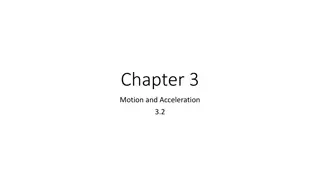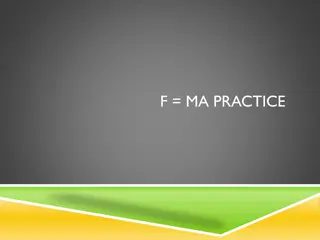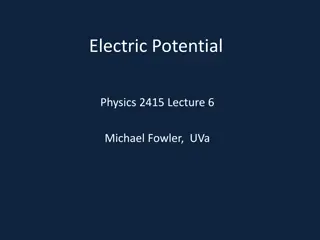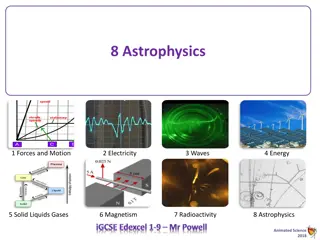Understanding Gravitational Anomalies and Interpretation Challenges
Gravitational anomalies pose an inverse problem in determining characteristics of underlying bodies. Surface gravity values provide insights into geometric shape, dimensions, density contrast, and depth. Interpreting anomalies requires integrating gravimetric analysis with other geological data. Cal
5 views • 62 slides
Understanding Acceleration in Physics
Acceleration is the rate at which velocity changes, encompassing both increases and decreases in speed. In physics, acceleration is defined as the rate of change in velocity, making it a vector quantity due to its directional nature. This article explores the concept of acceleration, including examp
0 views • 15 slides
Understanding Rotational Motion: Angular Velocity and Acceleration
Explore the concepts of angular velocity, radians, and rotational motion in this educational content. Learn about the relationship between angular and linear velocity, angular acceleration, tangential acceleration, and centripetal acceleration through practical examples. Enhance your understanding o
2 views • 17 slides
Gravitational Potential Energy Equations and Examples
Learn how to rearrange the potential energy equation, calculate potential energy using the formula PE = mgh, and solve for mass and height in relation to gravitational potential energy. Explore examples of calculating potential energy for objects at different heights. Understand the concept of gravi
0 views • 11 slides
Understanding Motion Under Constant Acceleration
Constant acceleration refers to motion where the speed increases by the same amount each second. It is exemplified in scenarios like free fall due to gravity, where objects experience a consistent acceleration of approximately 10 meters per second squared. This type of motion plays a significant rol
0 views • 11 slides
Understanding Speed vs. Time Graphs: Analyzing Acceleration and Motion
Explore the concept of speed vs. time graphs and learn how to recognize acceleration, interpret speed, analyze motion, and calculate acceleration from the slope of the graph. Discover the characteristics of graphs showing constant acceleration, varying acceleration, and deceleration. Engage in drawi
0 views • 19 slides
Understanding Acceleration in Motion: Concepts and Examples
Delve into the world of acceleration in motion with this informative content. Learn how acceleration is defined, its relationship with velocity, and the different types of acceleration - positive, negative, and zero. Examples like a car at a stoplight, a bouncing ball, and a jet airliner on a runway
0 views • 8 slides
Understanding Gravitational Potential Energy
Explore the concept of gravitational potential energy and its relation to mass, height, and gravitational field strength. Learn about kinetic energy, equations for GPE, rearranged equations, and practical applications through examples and challenges.
1 views • 14 slides
Exploring Gravitational Quantum States of Antihydrogen
The research delves into the intriguing realm of gravitational quantum states of antihydrogen, posing questions about the feasibility of gravitational mass extraction from these states. Through topics like spectroscopy, interference, and time-spatial resolution, the study sheds light on the properti
0 views • 21 slides
Advances in Optical Bench Technology for Gravitational Wave Detectors
This content discusses the latest advancements in optical bench technology for gravitational wave detectors, focusing on precise measurements of back-scattered light, development of new optical cavities, and testing of Sagnac interferometers. Key objectives include improving suspension controls, red
0 views • 13 slides
Indian Contributions to General Relativity Post-Independence Era
Indian scholars have made significant contributions to the field of General Relativity post-independence, focusing on important problems like Big Bang singularity, gravitational collapse, black holes, gravitational waves, and quantum aspects. Notable achievements include AKR's Raychaudhury Equation,
0 views • 30 slides
Gravitational Radiation Driven Capture of Black Holes in Clusters
Explore the dynamics of black hole binary formation in clusters, focusing on gravitational radiation-driven capture processes. Delve into the implications of gravitational wave emissions on orbit transitions and energy radiation. Discover critical impact parameters and approaches to understanding th
3 views • 21 slides
Acceleration Analysis of Slider Crank Mechanism
In this analysis, we calculate the acceleration of the slider at point B, acceleration of point E, and the angular acceleration of the link AB in a slider crank mechanism. The steps involve drawing configuration, velocity, and acceleration diagrams with suitable scales to determine the necessary par
0 views • 12 slides
Understanding Acceleration and Gravity in Physics
Explore the concepts of acceleration and gravity in physics through engaging images and key points. Learn about mass, weight, Newton's Law of Gravitational Attraction, and the acceleration due to Earth's gravity. Discover how all objects fall at the same rate regardless of mass and what factors can
3 views • 31 slides
Variation of the Acceleration Due to Gravity with Latitude
Explore the variations in acceleration due to gravity with latitude through insightful images created by Shashi Kant Kumar, Assistant Professor of Physics at M.H.M. College, Sonbarsa. The images visually depict how gravitational acceleration changes with different latitudes, providing valuable insig
0 views • 11 slides
Understanding the Acceleration of the Universe and the Equivalence Principle Violation in the Horndeski Vector-Tensor Theory
Exploring the implications of the Equivalence Principle Violation after reheating in the context of the accelerated expansion of the universe. The study delves into the Horndeski vector-tensor theory, gravitational waves, and the impact of modified gravity and dark energy. Insights are provided on t
2 views • 20 slides
Understanding Gravitational Forces Between Earth and Moon
Exploring the gravitational forces between Earth and the Moon, we learn that they pull on each other equally due to Newton's 3rd Law. The force depends on the distance squared, meaning doubling the distance reduces the force by a factor of 4. When in an airplane at high altitude, your weight is less
1 views • 21 slides
Understanding Acceleration in Physics
Explore the concept of acceleration through real-world scenarios involving moving objects and graphs. Learn how to determine the direction of acceleration based on the velocity changes of cars, divers, bungee jumpers, and more. Delve into examples of calculating average acceleration and final veloci
0 views • 11 slides
Effect of Weighted Sled Towing and Weighted Vest on Sprinter Acceleration Performance
Short distance running involves crucial phases affecting sprint performance, with acceleration being particularly important. Training methods like weighted sled towing and weighted vest usage have been found effective in enhancing sprint acceleration. This study investigated the impact of these meth
0 views • 8 slides
Mechanics Practice Problems with Force and Acceleration
Solve practice problems involving force, mass, and acceleration in physics. Calculate net force accelerating a bicycle, mass of the Space Shuttle based on thrust and acceleration, acceleration of a runner given force and mass, and acceleration of a car with a known force and mass.
0 views • 5 slides
Understanding Electric Potential and Gravitational Energy in Physics
Explore the concepts of electric potential and gravitational energy in physics through insights on lifting a rock, potential energy of charges, and more. Learn about the similarities between gravitational and electric fields, as well as the definition of potential, potential energy, and work in thes
0 views • 20 slides
Concepts in Gravitational Forces and Celestial Bodies
This informative content delves into various concepts related to gravitational forces and interactions between celestial bodies like the Earth and the Moon. It covers topics such as the comparison of gravitational pulls, forces in concentric orbits, weight measurements in different scenarios, and th
0 views • 11 slides
Understanding Kepler's Third Law and Gravitational Work
Kepler's third law relates the orbital period of a planet to its distance from the Sun. In this scenario, we calculate the work required to lift an astronaut from Earth to the ISS and remove them from Earth's gravitational field. We also determine the initial speed needed to project the astronaut fr
0 views • 14 slides
Understanding Gravitational Potential Energy and Negative Potential Energy
Exploring the concept of gravitational potential energy beyond the surface of Earth, understanding how potential energy varies with distance from the Earth's center, and delving into the significance of negative potential energy at certain points. Learn about the calculations involved, including the
0 views • 17 slides
Exploring Gravitational Effects and Space Curvature in Accelerating Frames
Explore the implications of equivalence in gravitational effects like redshift, time-warp, and space-warp in accelerating frames. Understand how the curvature of space is linked to non-uniform gravitational fields. Dive into observations confirming these phenomena, shedding light on the nature of sp
0 views • 30 slides
Understanding Gravity and its Applications
Explore the fascinating world of gravity through topics like the law of gravity, gravitational force, superposition, and more. Dive into concepts such as net gravitational force, acceleration due to gravity, and gravitational forces in various scenarios. Understand how gravity influences objects in
0 views • 68 slides
The Legacy of Joe Weber in Gravitational Wave Detection
Joe Weber, a key figure in the history of gravitational wave detection, made significant original contributions to the field, despite facing conflicts and challenges. His groundbreaking work laid the foundation for future advancements in the detection of gravitational waves. The story of Joe Weber's
1 views • 19 slides
Advanced LIGO and Short Gamma-Ray Burst Search Overview
Advanced LIGO is focused on achieving a lower noise level and higher sensitivity to detect gravitational waves. The search involves analyzing data from the 1st Advanced LIGO Science Run, collaboration with Fermi, and seeking coincident detections of gravitational waves and gamma-ray bursts, particul
0 views • 13 slides
Non-Riemannian Geometry and Born-Infeld Models in Gravitational Theory
In this paper by Diego Julio Cirilo-Lombardo, a non-Riemannian generalization of the Born-Infeld Lagrangian is introduced in the context of gravitation with a dynamical torsion field. The resulting field equations lead to a trace-free gravitational equation and provide insights into primordial magne
0 views • 34 slides
Experimental Determination of Acceleration of Free Fall
Experimentally determining the acceleration of free fall by analyzing the motion of an apple and a feather falling in a vacuum. By scaling and analyzing the data, the acceleration is calculated to be approximately 9.82 m/s^2, indicating a constant acceleration due to gravity.
0 views • 13 slides
Understanding Astrophysics: Forces, Motion, and Gravitational Fields
Explore the realm of astrophysics through forces, motion, energy, and gravitational fields. Delve into topics like orbits, velocity, and the fundamental units of measurement, all depicted in engaging visual representations. Gain insights into the vastness of the universe, galaxies, stars, and planet
0 views • 9 slides
Environmental Monitoring of Virgo Irene Fiori European Gravitational Observatory Visit
The environmental monitoring of Virgo at the European Gravitational Observatory involves studying various environmental influences on the interferometer, such as electromagnetic fields, radio waves, ground motion, and mechanical vibrations. Sensors are strategically placed in experimental halls to d
0 views • 12 slides
Acceleration Management Architectures in OpenStack Nomad and DPACC
The figures depict the architecture of Software Acceleration Layer (SAL), Acceleration Management Layer (AML), and other components in OpenStack Nomad and DPACC. They illustrate the interaction between Software Routing Layer (SRL), General Drivers (g-drivers), Hardware I/O Interface (hio), and more
0 views • 4 slides
Study of Optical Scatterers Within Coating Layers of Gravitational Wave Detector Mirrors
Analyzing scattering points within Advanced LIGO mirror coatings revealed unexpected weak scatterers, potentially influencing energy losses and thermal noise in gravitational wave detectors. Individual scatterers were identified using DAOPHOT, an algorithm originally created for astronomy, to pinpoi
0 views • 23 slides
Unveiling the Role of Radio and Plasma Waves in Particle Acceleration
Radio and plasma waves play a crucial role in the acceleration and loss of radiation belt particles. The Van Allen Probes provide groundbreaking multipoint measurements of these waves in various regions, shedding light on phenomena such as chorus waves and resonant wave acceleration. Strong correlat
0 views • 8 slides
Unveiling the Fascinating History and Science of Gravitational Wave Astronomy
Delve into the intriguing world of gravitational wave astronomy, from Einstein's initial predictions in 1916 to the recent breakthroughs in detecting these elusive waves. Explore the generation of gravitational waves, their impact on matter, and the key players in unraveling the mysteries of the uni
0 views • 44 slides
Exploring Gravitational Energy and Its Limitations
Delve into the concept of gravitational energy, its practical applications, and limitations. Understand the relationship between gravity, work, and energy in a gravitational field, while also exploring topics such as escape energy, escape speed, binding energy, and the preservation of mechanical ene
0 views • 37 slides
Understanding Universal Law of Gravitation in Physics
Explore the concept of Universal Law of Gravitation in Physics, including gravitational force, gravitational attraction between objects, and gravitational field strength. Learn to calculate these values with equations and examples showcasing the fundamental principles of gravity.
0 views • 9 slides
Understanding Newton's Second Law of Motion
Exploring Newton's Second Law of Motion which states that an unbalanced force acting on a particle causes acceleration proportional to the force. The law is expressed as F=ma, highlighting the relationship between force, mass, and acceleration. Additionally, the concept of gravitational attraction a
0 views • 15 slides
Understanding Gravity and Inverse Square Relationships in Physics
Explore the concepts of gravitational field, potential, geostationary orbits, escape velocity, and the inverse square relationship in Newton's Law of Universal Gravitation. Discover how mass and distance affect gravitational force and learn about nonuniform gravitational fields and equipotential lin
0 views • 22 slides







































